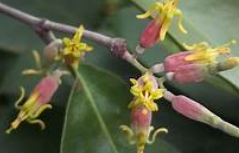Host-Plant Species Effect on Anti-Diabetic Activity of African Mistletoe (Loranthus bengwensis) in STZ induced Diabetic Rats http://www.doi.org/10.26538/tjnpr/v7i9.38
Main Article Content
Abstract
African mistletoe (Loranthus bengwensis) is a hemi-parasitic plant which grows in all parts of Nigeria. It is used in the form of tisane (decoction), as a traditional herbal treatment for various forms of ailments especially as an anti-diabetic. The present study evaluated the host-plant effect on the anti-diabetic activity of the African mistletoe growing in the Northern part of Nigeria. Streptozotocin (STZ)-induced diabetic male Wister rats were orally administered with decoction (0.01 g/cm3) of African mistletoe, parasiting on lemon (Citrus limon), guava (Psidium guajava) and jathropha (Jathropha curcas) trees respectively for 28 days (ad libitum) as the only source of fluid. The decoction from African mistletoe parasiting on lemon and guava trees were found to cause a significant reduction in the blood glucose level (40%) of the diabetic rats while the decoction prepared from the jathropha tree caused a significant elevation of blood glucose (60%) in the STZ-induced diabetic rats. The results obtained indicated that Africa mistletoe possesses significant anti-diabetic activity and this anti-diabetic activity may be influenced by the hostplant species.
Downloads
Article Details

This work is licensed under a Creative Commons Attribution-NonCommercial-NoDerivatives 4.0 International License.
How to Cite
References
Richardson INK. Lorantaceae (Mistletoe). In: Flowering plant of the world (Heywood, V. H. et al eds). Oxford University Press, Oxford London Melbourne 1979. 174 - 175.
Adesina SK, Iloh HC, Johnny II, Jacobs I.African Mistletoe (Loranthacae) Ethnopharmacology, chemistry and medicinal value: An update. Afri. J. Trad. Compl. And Altern. Med. 2023; 10(4):161-170
Obatomi DK, Bikomo EO, Temple VJ. Antidiabetic properties of the African mistletoe in streptozotocin induced diabetic rabbits. J. Ethnopharmacol. 1994; 43: 13–17.
Osadolor HB and Ojewe DD. Aqueous extracts of African mistletoe (Loranthus bengwensis) leaves exert hypoglycaemic effects in normal rabbits. Int J. Nig. Soc Expt. Biol. 2014; Vol. 26 (3) 85–87.
Rossini AA, Like AAA, Chick WL, Appel MC, Cahill Jr GF. Studies of streptozotocin-induced insulitis and diabetes. PNAS. 1977; 74 (6): 2485-2489. Doi:10.1073/pnas.74.6.2485
Szkudelski T. "The mechanism of alloxan and streptozotocin action in B cells of the rat pancreas". Physiol Res. 2001; 50(6):537–546.
Tarfai FD. Amos S, Temple VJ, Ochekpe NA and Gamaniel KS. Hypoglycemic effects of the aqueous extract of African Mistletoe, Tapinanthus sesselifolius (P. Beauv) van Tiegh (Loranthaceae). Int. J. Biochem Sci. 2012; 6(1): 408-414.
Osadolor HB, and Ojewe DD. Hypoglycaemic effect of aqueous extract of African mistletoe (Loranthus bengwensis) leaves in normal rabbits Cont. J. Appl Sci. 2008; 3: 21 – 24.
Ozougwu C. Nigerian Medicinal Plants with Anti-Diabetic and Anti-hypertensive Properties. European J. Med Plants. 2017; (3): 1-9 DOI: 10.9734/EJMP/2017/37468.
deBoer HJ; Cotingting C. “Medicinal plants for women healthcare in Southeast Asia: A meta-analysis of their traditional use, chemical constituents and pharmacology.” J Ethnophamacol. 2014; 151 (2): 747-767.
Gupta P and Birdu T. Psidium guajava leaf extract prevents intestinal colonization of Citrobacter rodentium in mouse model: J-AIM. 2015; 6 (11): 50-52.
Mathur R, Dutta S, Velpandian T and Mathur SR. Psidium guajava Lin leaf extract affect hepatic glucose transporter -2 to attenuate early onset of insulin resistance consequent to high fructose intake: An experimental study. Pharmacol Res. 2015; 7(2):166-175.
Constantin RP, Bracht A, Yamamoto NS, Ishii-Iwamoto EL, and Constantin J. Molecular mechanisms of citrus flavonoids on hepatic gluconeogenesis. Fititerapia. 2014; 92: 148-62.
Mukkar GG, Harinder PS, George F, Klaus B. “Phorbol Esters Structure Biological Activity and Toxicity in Animals.” Int. J. Toxicol. 2016; 26 (4): 279 – 288.
Moshobane MC, Wium C, Mokgola LV. Acute poisoning in children from Jatropha curcas seeds. SAJCH 2017; Vol. 11 No. 3 DOI: 10.7196/SAJCH.2017; v11i3.1401.
Kulkarni ML, Sreekar H, Keshavamurthy KS, Shenoy N. Jatropha curcas-poisoning. Indian J Pediatr. 2005; 72:75– 76.
Gupta A, Kumar A, Agarwal A, and Osawa M. Acute accidental mass poisoning by jatropha curcas in Agra, North India. EJFS 2016; 6(4): 496–500.
Irving LJ, Cameron DD. You are what you eat: interactions between root parasitic plants and their hosts. Adv Bot Res. 2009; 50:87–138.
Těšitel J; Plavcová L and Cameron, DD. Interactions between hemi-parasitic plants and their hosts. The importance of organic carbon transfer. Plant Signal Behav. 2010; 5 (9) 1072-1076.doi: 10.4161/psb.5.9.12563


